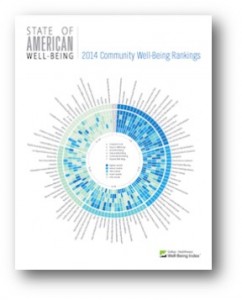Three CT Metro Regions Reach Top 50 in USA for Well-Being of Residents
/The well-being of residents in three of Connecticut’s metropolitan areas are among the nation’s top 50, ranking at #36, #37 and #48 in a national survey of community well-being that evaluated the top 100 metro regions in the country.
The 2014 Community Well-Being Rankings are the latest annual surveys by the polling company Gallup and the consulting firm Healthways. Reaching the top 50 from Connecticut were the Bridgeport-Stamford-Norwalk region (#36), West Hartford-Hartford-East Hartford (#37), and New Haven-Milford (#48), based on U.S. Census tract data. 
The Gallup-Healthways Well-Being Index, surveyed residents to get a sense of their social, physical and financial health, as well as their sense of purpose and connections to their community -- all factors that contribute greatly to worker productivity, societal health costs and the economic competitiveness of a place, according to the polling firms as reported by Governing Magazine.
The 2014 rankings are based on 55-question surveys of about 176,000 people across all 50 states. The score for each community included metrics affecting overall well-being and five elements of well-being:
- Purpose: liking what you do each day and being motivated to achieve your goals
- Social: having supportive relationships and love in your life
- Financial: managing your economic life to reduce stress and increase security
- Community: liking where you live, feeling safe and having pride in your community
- Physical: having good health and enough energy to get things done daily
 The Bridgeport-Stamford-Norwalk region ranked #5 in physical health, #43 in financial health, #58 in community ties, #63 in sense of purpose and #88 in social health.
The Bridgeport-Stamford-Norwalk region ranked #5 in physical health, #43 in financial health, #58 in community ties, #63 in sense of purpose and #88 in social health.
The Hartford - West Hartford – East Hartford region ranked #18 in financial health, #20 in physical health, #30 in social health, #61 in sense of purpose and #62 in community ties.
The New Haven-Milford region ranked #6 in physical health, #47 in sense of purpose, #48 in social ties, #50 in financial ties, and #91 in community ties.
The South, Southwest and West Coast dominated the top 30, with Boston the only Northeast city, reaching that high. California, North Carolina, Texas all have two communities in the top 10.
Leading the list was Florida’s North Port-Sarasota-Bradenton area, which performed especially well in financial and physical health. Honolulu, Raleigh, California’s Oxnard-Thousand Oaks-Ventura area and El Paso, Texas, rounded out the top five.
El Paso was the only community to take the top ranking in two categories: sense of purpose and physical health. That was also the only category to see a Connecticut metropolitan area reach the top 10. Elsewhere in New England, Providence-Warwick ranked #70.
The survey found that residents of high well-being communities exercise more frequently -- an important aspect of physical well-being -- but they are also more likely to report that someone close to them encourages them to be healthy, a critical component of social well-being. They are much less likely to be obese, they have fewer significant chronic health conditions, and they feel safe where they live. Those who feel safe where they live are, in turn, more likely to have access to a safe place to exercise and access to fresh produce, which are important community characteristics that are linked to lower levels of obesity.
Each community, defined as a metropolitan statistical area under the U.S. Census Bureau, received a rank in each category according to the strength of the responses from their residents and an overall rank as well.
Residents of the top well-being locations in the U.S. are “more likely to be thriving across each of the five critical elements of well-being, thus capitalizing on the synergistic benefits of each element acting in concert with one another,” the survey analysis indicated. “This may reflect what is perhaps the most important factor separating the nation's high well-being communities from those with lower well-being: a holistic view of well-being.”





























